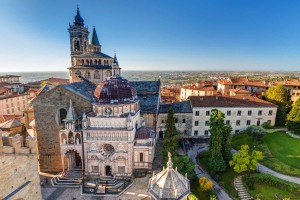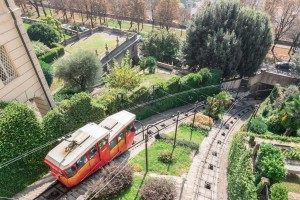
©Bigstock.com/Patryk Kosmider
Bergamo is situated at the segue between the last foothills of the Alps and the fertile Po Valley, right in the heart of Lombardy. This stunning city with around 120,000 inhabitants can look back on a unique, highly eventful history that most definitely left its mark on the contemporary structure. The old upper city located on a hill used to be one of the centrepieces of the Republic of Venice and is surrounded by a UNESCO World Heritage Site with the distinctly more modern lower city situated around it. Both city centres are connected by cable cars that transport locals and tourists back and forth. Jump in and let our tour begin!
Historic foray through Bergamo
Bergamo’s ideal location on a hill attracted first settlers very early. The Celtic tribe of Cenomani were here first with the Romans only conquering the region in 196 BC and calling it Bergomum. Around 10,000 citizens used to live in the municipium at its peak. Like many other Northern Italian cites, it was pillaged right before the fall of the Western Roman Empire. After a long period of Carolingian rule Bergamo would become an independent commune – an era mostly dominated by conflicts with Brescia and by the Lombard League.
Having been ruled by Bohemia, Milan and the House of Malatesta at different periods of time, Bergamo would eventually fall to the Republic of Venice after the Battle of Maclodio. Several French and Spanish conquests – Venice always managed to quickly regain the city – led to a decisive extension of the defensive fortifications. The massive city walls around the old town with its originally 14 bastions and four heavily guarded gates were declared UNESCO World Heritage Site in 2017. Bergamo was conquered by Napoleon – like many other Northern Italian cities – was incorporated into the Kingdom of Lombardy-Venetia in 1815 and became an important hub of the Risorgimento. The city provided the largest share of the so-called Garibaldini during the Expedition of the Thousand and would eventually become part of the new Italy.
The cable cars

©Bigstock.com/KYNA STUDIO
Numerous bus lines aside, the two cable cars are particularly important for Bergamo’s public transport. The first ideas were developed during the second half of the 19th century when the upper city on the hills faced increasing isolation and commercial crisis. Today two funiculars operate in Bergamo:
- Città Alta: The upper city’s crisis escalated when the city council moved to the lower city. A funicular from the northern edge of the lower city (Viale Vittorio Emanuele) to the northern edge of the upper city (Piazza Mercato delle Scarpe) turned out to be the solution. The cabins eventually gave way for inclined lifts that overcome falls of up to 52%. The funicular to Città Alta remains a popular means of transport among locals and guests.
- San Vigilio: This cable car inside the north-western upper city to the eponymous hill offers an amazing view across Bergamo and provides access to most of the Venetian defensive fortifications. Nowadays, mostly tourists travel to the castle at an altitude of 496 m.
Piazza Vecchia and Piazza del Duomo

©Bigstock.com/KYNA STUDIO
Most of Bergamo’s major sights are in the old upper city, grouped around the two central squares: Piazza Vecchia and Piazza del Duomo. Here are some of the must-sees you get to experience at and around these hotspots:
- Palazzo della Ragione: The brick-built façade of the town hall that looks a bit like an ancient Roman basilica dominates Piazza Vecchia. Several fires destroyed most of Palazzo della Ragione leading to its eventual restauration in the 16th century utilising late Gothic elements. The large market hall is currently used as a fresco museum.
- Campanone: One of the city’s landmarks is right next to the palazzo. You can see the Campanone or Torre civica from afar. It is 52.76 m high and towers over most of Bergamo. 230 steps or, if you prefer a more comfortable solution, a lift lead to the top.
- Cathedral: Bergamo’s cathedral is on Piazza del Duomo. Excavations suggest that the first churches here were built in the 5th The current building was started in the mid-15th century and only finished in 1693 after a break of almost two centuries. The white-marble façade almost glows hiding a monumental structure with rich adornment behind it. An archaeological area below the portico unearths the basilica’s exciting history from early Christian times to now.
- Santa Maria Maggiore: Originally a Romanesque concept that remained incomplete, works on the basilica Santa Maria Maggiore commenced in 1137. A transept façade with porch was added in 1530 before everything was eventually revamped in baroque style. The fascinating figurines on the outer walls create an equally fascinating contrast to the frescos and tapestries on the inside. The basilica is the final resting place of the composers Gaetano Donizetti and Johann Simon Mayr.
- Cappella Colleoni: This sepulchral church commissioned by Bartolomeo Colleoni in 1471 is probably the most striking building on Piazza del Duomo. It houses the tomb of the mercenary leader and that of his daughter Medea who died aged only twelve. This masterpiece of Renaissance architecture and decorative arts impresses both as a whole and in its details. The façade alone with its pillars, the rose window, tympanum and aedicula will wow you, and don’t even get us started on the unbelievably grand interior.
Additional highlights in Bergamo
There are many more places and squares beyond the historic old city you absolutely must visit. We recommend the following sights in the upper city and in the lower city:
- Accademia Carrara: The art academy plus art museum in the lower city started out in the late 18th century when art patron Giacomo Carrara left an extensive collection to the city of Bergamo. During your visit you get to see works by Botticelli, Raffael, Pisanello and Raffael plus numerous prints and drawings, sculptures, porcelains, furniture, bronzes, and a collection of medals.
- GAMeC: The Galleria d’Arte Moderna e Contemporanea, GAMeC, has been in the building opposite the neo-classical Accademia since 1991. This gallery for modern and contemporary art presents its exhibits in ten rooms spread across three floors.
- Orto Botanico: A long walk onto Colle Aperto leads to the city’s botanical gardens, open daily in the warm season. Established in 1972 and named after the physician and botanist Lorenzo Rota, it is home to a plethora of alpine and exotic plants.
- Teatro Donizetti: A fire – presumably arson – destroyed Bergamo’s opera in 1797, only a few years after it had been opened. A new building was needed. Today’s Teatro Donizetti – renamed in honour of the 100th birthday of composer Gaetano Donizetti in 1897 – truly is something special with its horseshoe shape. You can find a Donizetti monument in the adjacent park.
- San Michele al Pozzo Bianco: This final treat awaits you in the eastern upper city. The roots of this small church date back to the 8th century, the current building was constructed in the 14th century, and the façade is about 100 years old. San Michele al Pozzo Bianco is particularly known for its impressive frescos inside the Marian chapel, at the altar and in the crypt.
From upper city to lower city, from magnificent buildings to contemporary art – Bergamo impresses with astounding variety within and around the Venetian city walls that, being a World Heritage Site, would be reason alone to visit this gem in the heart of Lombardy. Don’t miss out on this charming cultural and architectural highlight!